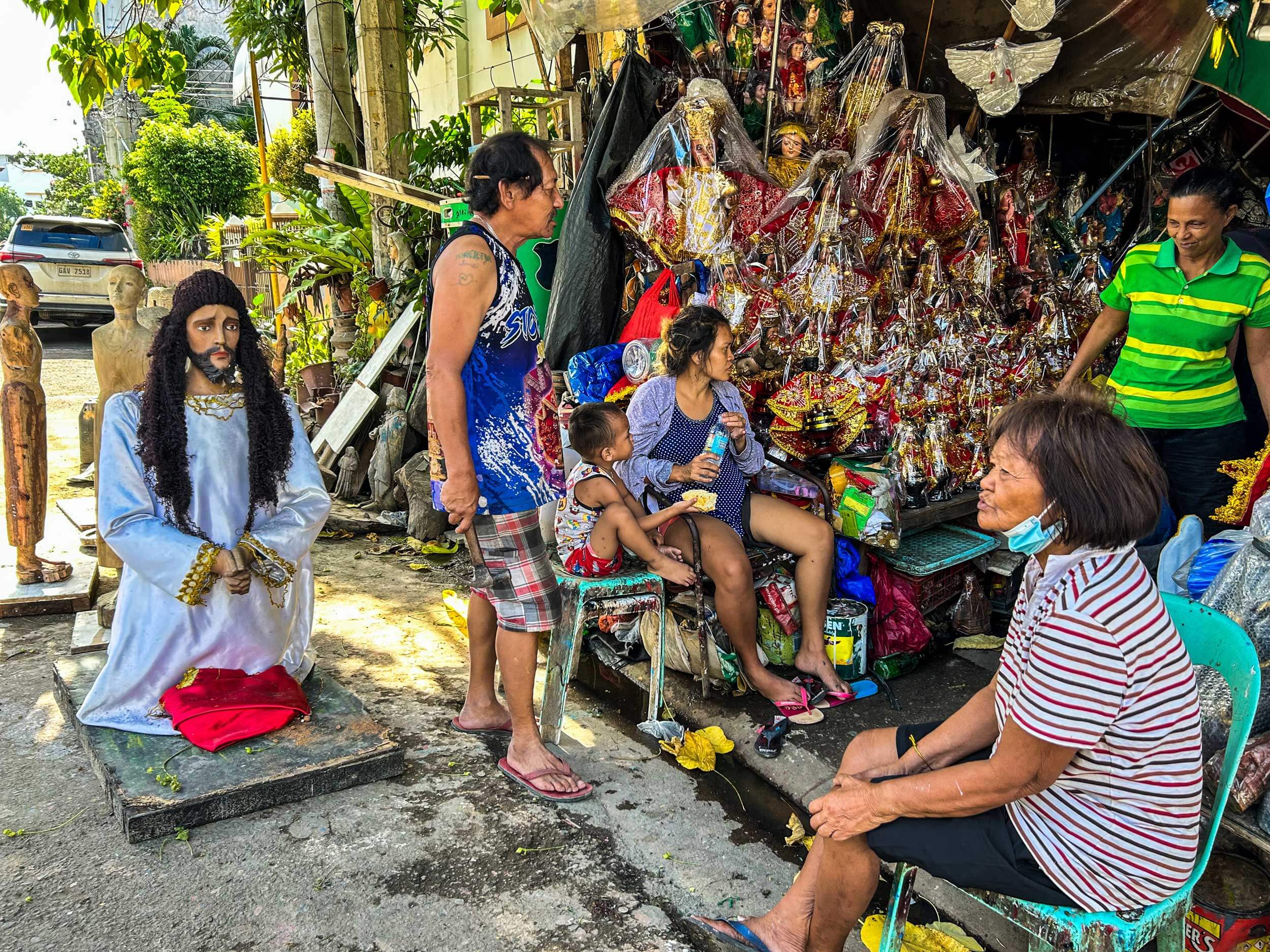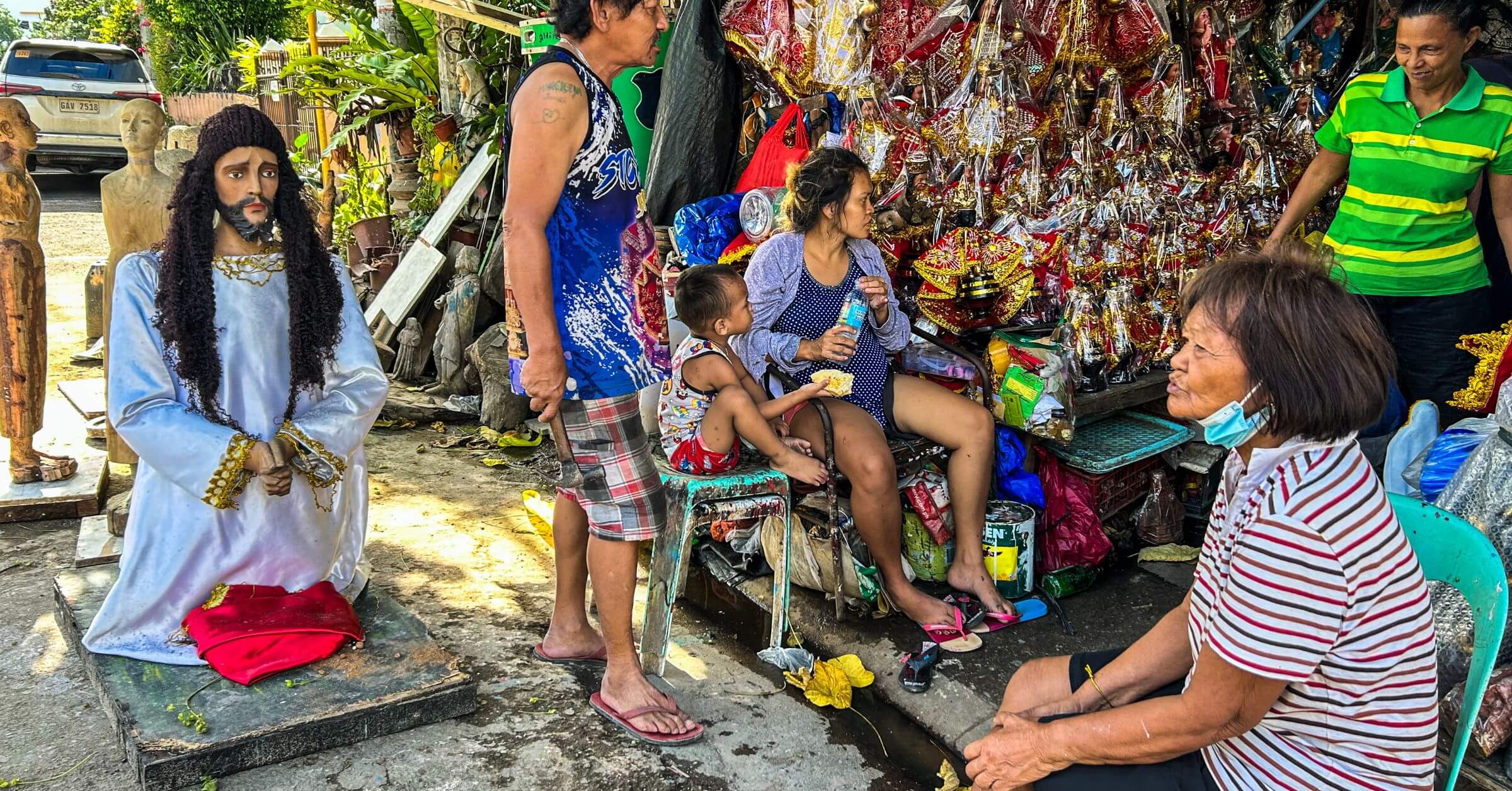On the trail of St. Vitalis of Milan, I found myself at this stall selling religious images behind the Cebu Metropolitan Cathedral.
St. Vitalis was an early Christian martyr described by some as apocryphal but who was designated the patron saint of Cebu City or the old Ciudad de Cebu or the Villa San Miguel settlement set up by Miguel Lopez de Legazpi or just the Cebu Metropolitan Cathedral. There is some confusion, one historian wrote. A wry understatement.
Several priests and a bishop I interviewed say St. Vitalis is patron saint of the Cebu Metropolitan Cathedral and only of the cathedral. Historians, however, wrote that he is patron of the City of Cebu. In “The Feast of the Santo Niño,” Dr. Resil Mojares lists under the section “A Litany of Saints” that Cebu City was founded as a parish in 1571 with the patron “San Vidal.”
Jesuit Pedro Chirino writing in 1600, Augustinian Juan de Medina in 1630, and Felipe Redondo in 1886 all described the “glorious martyr St. Vidal” as patron saint of Cebu City. The comprehensive historical recounting of this is “In the Shadow of the Santo Niño: San Vidal’s Sojourn in Cebu City, 1565–2018,” a paper by Dr. Michael Cullinane.
I’ve been interviewing people on the subject these past few weeks for an upcoming blog post about San Vidal at MyCebu.ph and the attempts at reviving his devotion.
The designation of St. Vitalis as patron saint of Cebu was by an accident of date. It just happened that Legazpi landed in Cebu on April 28, 1565, the feast day of St. Vitalis. As was their custom, he dedicated the place to the saint whose feast day fell on that occasion, San Vidal.

The Spaniards, however, also discovered the Sto. Niño that day – an event that we commemorate today as the Kaplag – and Cebuano faith has since been defined by our fervent devotion to the Sto. Niño and profound unawareness, even rejection, of San Vidal.
In Spanish times, he was much celebrated and his feast day was marked with civic parade, bull fights, and horse races. He bannered the Pendón de Castilla, the Spanish standard, in his procession. San Vidal was closely associated with the colonial administration, said Cullinane.
At the close of the 19th century, “the feast of San Vidal remained at the center of the city’s civic life,” Cullinane wrote. But during the uprising against Spanish rule, the rebels destroyed “el pendón de San Vidal.”
He disappeared from Cebuano Catholic consciousness after the Spaniards left, displaced by the focus of devotion on the Sto. Niño and eased out of the cathedral by the introduction of the devotion to the Immaculate Conception.
Cullinane said Archbishop Reyes had the images of San Vidal and the Guardian Angels removed from the retablo on the Gospel side (left when facing the altar, you heathens). The cathedral was damaged during World War II.
“After the war, it would take nearly eight years of reconstruction before Cebu’s Metropolitan Cathedral reemerged as a functional church. Among the sacred objects lost in the war was the image of San Vidal,” Cullinane wrote.
Today, there is an image of San Vidal in the retablo on the Gospel side. He’s back inside the church after briefly being exiled outside it. San Vidal occupies the retablo with his martyred wife and their two sons.
I asked Marcelina Pugoy at her stall behind the cathedral whether she sold any image of San Vidal and she told me, “Ikaw ra may nangita anang Vitalis, Dong.” (You’re the only one who asked about Vitalis)
“I kulit man na kay wala may hulma,” Pugoy told me. (The image will have to be carved because we don’t have a mould for it.)
She said it was more expensive – P3,500 for a one-foot image – and I would have to provide her a picture but they could also base it on the one at the cathedral. A regular image costs just P700.
Have you ever sold an image of St. Vitalis? I asked Pugoy. Only once, she said. It was to then Monsignor Ruben Labajo when he was assigned to the Cathedral. Nyor Ruben is now an Auxiliary Bishop and was instrumental in the attempt at reviving the devotion to St. Vitalis at the cathedral. He even went to the Basilica of San Vitale in Ravenna, Labajo said in an interview.
Pugoy is the person shown in this photo. In front of her is an image of Jesus Christ at the Garden of Gethsemane. The buyer returned the image and asked that Christ’s head be adjusted so he looked up.
Pugoy, who is 69, has been selling religious images in the area since 1975. She was born there and then abandoned by her parents. She said a nun at the cathedral took pity on her and her siblings and helped them. They started making a living as children by selling candles and offering prayers. Without a prompt, she proudly recounted to me all the parish priests assigned to the cathedral since the 1950s.
Pugoy said she started selling images of saints when a businessman offered her some items to sell on consignment. She said the popular images are those of the Sto. Niño and the different manifestations of the Virgin, including Lourdes. “Dili ma-ihap,” she answered when I asked how many images of the Sto Niño they sell. (We can’t say how many.)
Pugoy sells images on the sidewalk across the Chancery of the Archdiocese of Cebu, which is located in the St. Vitalis Building.
Max is a journalist and blogger based in Cebu. He has written and edited for such publications as The Freeman, The Independent Post, Today, Sun.Star Cebu, Cebu Daily News, Philstar Life, and Rappler.
He is also a mobile app and web developer and co-founded InnoPub Media with his wife Marlen.


Leave a Reply